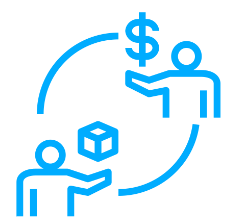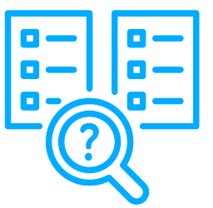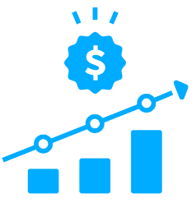Intent data. Chances are, your team has heard this buzzword A LOT in recent years. One reason is Google announced an end to third-party cookies to strengthen and protect web user privacy, which left many marketers running scared for a solution that can enhance personalization while adhering to user privacy.
The solution is to purchase intent data from third parties while collecting your own in-house (if applicable).
That may have you wondering, what is intent data? And, what are the benefits of intent data? In layman's terms, intent data is behavioral data that provides insight into what your prospects and leads search for on other websites (and yours if you conduct in-house research). According to Statista, U.S. marketers reported using intent data to improve delivery of targeted ad content (52%), email marketing (47%), personalization (44%), crafting messaging/content (36%), and more. And that's just the tip of the iceberg on what intent data platforms can improve for you.
Here's how to use intent data in your marketing, with ten steps to help you get started.

1. Begin Your Journey with a Plan
 Having a plan is a vital component of any successful marketing initiative. Being proactive in your planning makes your team 3X more likely to report success on campaigns that had intent data integrated into them.
Having a plan is a vital component of any successful marketing initiative. Being proactive in your planning makes your team 3X more likely to report success on campaigns that had intent data integrated into them.
The key is to start with the SMART goal(s) you're hoping to achieve — i.e., boost personalization, ad targeting, custom content, etc. — that include Specific details, Measurable results, Attainable objectives that are Relevant to your campaign, and achievable in a set Timeframe. For intent data, an excellent place to start your planning is a list of marketing and sales goals or strategies that would benefit most from the insight.
2. Educate the Team
 Intent data may be a hot topic right now, but that doesn't mean everyone is aware of what it is and its importance. That's why you should take the time to educate your entire team and organization before jumping right into it.
Intent data may be a hot topic right now, but that doesn't mean everyone is aware of what it is and its importance. That's why you should take the time to educate your entire team and organization before jumping right into it.
That will reduce any uncertainties about initiatives driven by intent data and ensure everyone is up to date on the best ways to leverage it in sales and marketing. Benefits like time-saving efforts, shorter sales cycles, and a much higher win rate will be optimized if everyone is properly prepped and prepared for integrating it into campaign strategies.
3. Pick Relevant Topics
 Intent data can only take you so far. It is up to you to choose the right topics for your campaigns for optimal utilization of the data you collect. Given that there are dozens to choose from, make sure you take the time to consider your options and pick the most relevant topics.
Intent data can only take you so far. It is up to you to choose the right topics for your campaigns for optimal utilization of the data you collect. Given that there are dozens to choose from, make sure you take the time to consider your options and pick the most relevant topics.
If you're unfamiliar with what an intent topic is, it refers to the nature of your digital content. For instance, the intent topic for this blog post would be intent data. It's the primary purpose of a piece and should align with the goal of your campaign. If you want to increase personalization, your intent topic must have a purpose specific to consumers in different segments and buyer journey stages.
4. Keep Topic Clusters Organized
 As a refresher, topic clusters are a group of intent topics that share similarities and represent your product and service characteristics. Keeping your clusters organized makes it easier for the team to evaluate and identify specific intent topic trends that can inform future decisions.
As a refresher, topic clusters are a group of intent topics that share similarities and represent your product and service characteristics. Keeping your clusters organized makes it easier for the team to evaluate and identify specific intent topic trends that can inform future decisions.
Moreover, this insight into topic interests among certain groups can guide the best way for you to appeal to customers at each stage of the buyer journey. You'll find consumers research several general topics in the Awareness stage as they're just getting used to their problems and potential solutions. In that first stage, research is their key intent. However, the following stages, Consideration and Decision, typically call for more specific, often technical, and detailed content to teach and inform prospects as their intent becomes more nuanced as they try to fulfill their pain points.
5. Don't Reach Out Too Soon
 Reaching out to prospects before they're ready to hear from you can deter the sale. Even after they've shown interest in a topic or two about your solution, it's imperative to give them time to familiarize themselves with their research. After all, 87% of people prefer to self-serve a portion of their buyer journey before being contacted. Instead, wait until they research about 20-25% of your topics to determine if they're relevant leads to your campaign.
Reaching out to prospects before they're ready to hear from you can deter the sale. Even after they've shown interest in a topic or two about your solution, it's imperative to give them time to familiarize themselves with their research. After all, 87% of people prefer to self-serve a portion of their buyer journey before being contacted. Instead, wait until they research about 20-25% of your topics to determine if they're relevant leads to your campaign.
6. Base Your Targeting on Your Prospects
 With intent data, you gain access to a host of information that informs you of your buyer accounts’ intent. What personalized ad and message topics will guide them through the funnel and right into your company's arms? If they're just starting their buyer journey, what generalized topics can you deliver to help resolve their problems while boosting your brand awareness?
With intent data, you gain access to a host of information that informs you of your buyer accounts’ intent. What personalized ad and message topics will guide them through the funnel and right into your company's arms? If they're just starting their buyer journey, what generalized topics can you deliver to help resolve their problems while boosting your brand awareness?
Letting your prospects lead your targeting ensures that you're reaching and resonating with buyers on a personalized level. This data-driven marketing method helps you reach the right audience, create more consistent messaging, avoid ad annoyance, build meaningful relationships, and better communicate the value of your brand and products or services.
7. Decide Who to Contact
 Every buyer account and lead can look the same at a glance, making sales and marketing’s task a bit daunting. Fortunately, intent data can help immensely to parse this out.
Every buyer account and lead can look the same at a glance, making sales and marketing’s task a bit daunting. Fortunately, intent data can help immensely to parse this out.
As you move into the seventh step of deciding who to call, use the insight you've gained on their level of interest in your brand or solution, as well as the topics they are interested in, to guide not only who to contact but what they need to hear and how to contact them to move them through the sales cycle efficiently.
8. Monitor Your Active Customers Against Competitors
 You should always have an eye on your competition. It's one of the best ways to continue improving your marketing and communication efforts while measuring your success compared to others in your industry. It's also imperative to evaluate the satisfaction of your current customers. After all, it will cost you 5X more to attain a new customer than it would to retain your existing customer accounts.
You should always have an eye on your competition. It's one of the best ways to continue improving your marketing and communication efforts while measuring your success compared to others in your industry. It's also imperative to evaluate the satisfaction of your current customers. After all, it will cost you 5X more to attain a new customer than it would to retain your existing customer accounts.
Use intent data to monitor and track current customer interest in the competition's topics. Are they researching your competitors? Are they showing more interest in their topics than yours? That informs and influences your decisions in two ways because it either:
- Signals dissatisfaction or disinterest in your brand/solutions. In which case, contact your sales team immediately to rectify the situation.
- May be a sign you need to expand your topics to better meet your current buyers’ interest.
9. Fully Integrate Intent Data into Your Sales and Marketing
 The next step in getting started is fully integrating your intent data into your sales and marketing. There's a reason 99% of large companies report using intent data in their sales and marketing strategies. If you're a part of the 1% who has yet to explore this data-driven marketing technique, you risk falling behind in your industry and struggling to connect on the personal level buyers have come to expect.
The next step in getting started is fully integrating your intent data into your sales and marketing. There's a reason 99% of large companies report using intent data in their sales and marketing strategies. If you're a part of the 1% who has yet to explore this data-driven marketing technique, you risk falling behind in your industry and struggling to connect on the personal level buyers have come to expect.
This step is crucial as it will give you a more holistic view of your current and potential customers, contributes to much deeper intelligence when combined with other data sets, and gives you the unique opportunity of leveraging intent data across the entire funnel.
10. Keep the Long-term in Mind
 Intent data is more than a short-term solution to hyper-targeting your audience and resonating with the right buyers at the moment they need to hear your message. It's a long-term solution to improving your personalization and relevance in the target market, constructing a better authoritative perception in the industry, and building and maintaining strong relationships with current and potential customers.
Intent data is more than a short-term solution to hyper-targeting your audience and resonating with the right buyers at the moment they need to hear your message. It's a long-term solution to improving your personalization and relevance in the target market, constructing a better authoritative perception in the industry, and building and maintaining strong relationships with current and potential customers.
BONUS: Partner with McClatchy
Getting started with intent data can be challenging, especially without the experience, knowledge, and expertise of the best ways to leverage it in your marketing plan. When you partner with McClatchy, you partner with a group of experts who have extensive knowledge and experience with helping brands put their intent data to use and several local media platforms with the insight you need on your customers to get ahead of the competition.
Contact us to learn more and follow our blog to get the latest in marketing and digital solutions.





